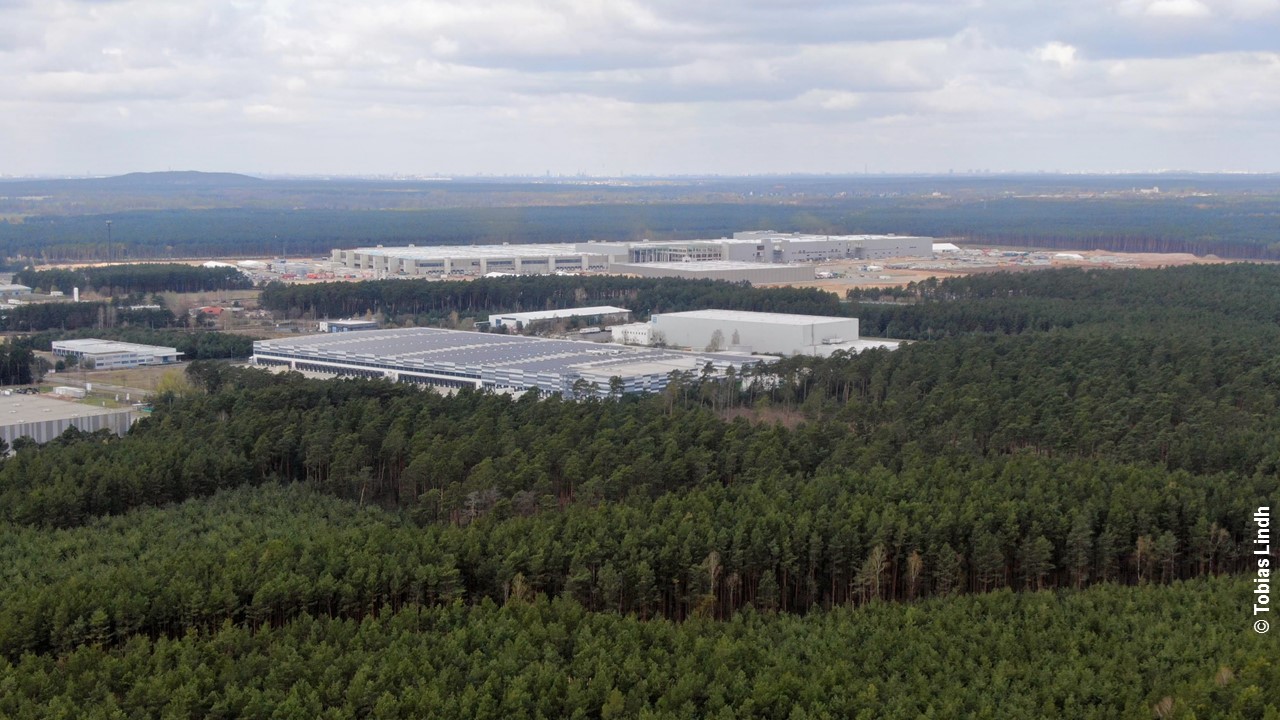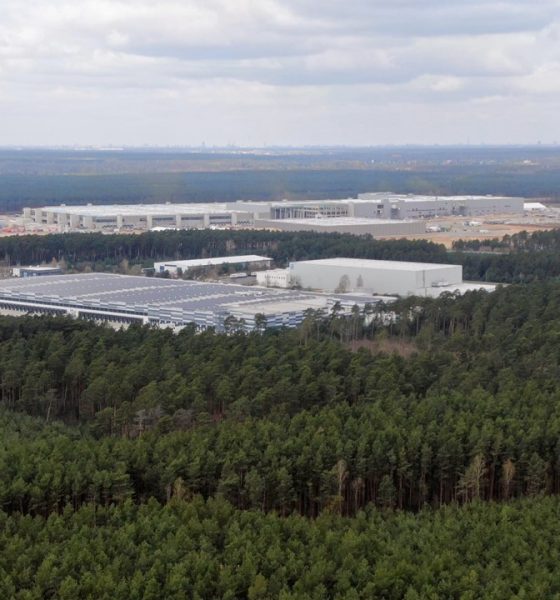

News
Tesla submits its application to build batteries at Giga Berlin
Tesla has officially submitted amended application documents to build electric vehicle battery cells at its German production plant, Giga Berlin.
On June 3rd, the Ministry of Agriculture, Environment, and Climate Protection (MLUK) announced that Tesla changed its application for the construction and operation of the Giga Berlin production facility. The changes were primarily due to the addition of the plan to produce electric vehicle battery cells on-site.
#Tesla hat geänderten Antrag u. a. mit Batteriezellenherstellung, Presswerkerweiterung & reduziertem Wasserverbrauch eingereicht. #LfU #Brandenburg wird nach Prüfung des Antrags über Öffentlichkeitsbeteiligung entscheiden; Auslegung ist wahrscheinlich.
?https://t.co/0sAH3WeyHq pic.twitter.com/9gRcnU5CuT— MLUK Brandenburg (@MLUKBrandenburg) June 3, 2021
Tesla has planned for Giga Berlin to become another battery manufacturing site for its electric cars for some time now. Since the facility was announced in late 2019 by CEO Elon Musk, Giga Berlin remains as somewhat of a hub for Tesla’s entire European operation. The vehicles built at the facility will not only be given to the citizens of Germany but the vehicles will be exported across the continent to help alleviate the demand that Tesla has obtained over the past few years. Europe remains as one of the most heavily-concentrated regions for electric vehicles, and Teslas, in particular, are highly popular in several countries, including Germany, France, Norway, and others.
Along with the demand for its vehicles, Tesla needs to continue to expand its battery production operation. In Germany, the company will install a “corresponding auxiliary device for vehicle production,” according to the MLUK press release regarding the matter.
The MLUK release says:
“The production of battery cells is now also to take place on site – for this purpose, a corresponding auxiliary device for vehicle production is requested. In addition, the application contains an expansion of the press shop with two more press lines, which should serve to expand the vertical range of manufacture in the plant.”
Tesla will manufacture its 4680 lithium-ion cells at Giga Berlin. The new, revolutionary cell was unveiled at Tesla’s Battery Day event in September 2020 and will give vehicles more range, power, and performance than its previously used 2170 batteries. Initially, Tesla will send cells from its Kato Road 4680 production lines in Northern California to Berlin.
EXCLUSIVE: Tesla Giga Berlin isn’t facing a 6-month delay: German Minister
Tesla also outlined a reduction in planned water consumption at the plant. Water consumption was one of the more talked about issues by local environmental groups, but Tesla plans to utilize significantly less water than previously estimated.
MLUK adds:
“In addition, the application contains various measures to reduce water consumption, so that despite the expansion of the plant, water consumption will probably continue to be around 1.4 million cubic meters per year and the expected amount of wastewater will be around 925,000 cubic meters per year.”
The Licensing Authority will decide whether the public should be involved in the decision-making process. Within the next few days, this will be decided.
Tesla slates its initial production phases for Giga Berlin at the end of 2021. Economic Minister of Brandenburg Jörg Steinbach expects production to begin by late-Summer or early-Autumn. As of now, the Model Y will still be the first vehicle produced in Germany at the Giga Berlin plant.
What do you think? Let us know in the comments below, or be sure to email me at joey@teslarati.com or on Twitter @KlenderJoey.

News
Tesla FSD fleet is nearing 7 billion total miles, including 2.5 billion city miles
As can be seen on Tesla’s official FSD webpage, vehicles equipped with the system have now navigated over 6.99 billion miles.

Tesla’s Full Self-Driving (Supervised) fleet is closing in on almost 7 billion total miles driven, as per data posted by the company on its official FSD webpage.
These figures hint at the massive scale of data fueling Tesla’s rapid FSD improvements, which have been quite notable as of late.
FSD mileage milestones
As can be seen on Tesla’s official FSD webpage, vehicles equipped with the system have now navigated over 6.99 billion miles. Tesla owner and avid FSD tester Whole Mars Catalog also shared a screenshot indicating that from the nearly 7 billion miles traveled by the FSD fleet, more than 2.5 billion miles were driven inside cities.
City miles are particularly valuable for complex urban scenarios like unprotected turns, pedestrian interactions, and traffic lights. This is also the difference-maker for FSD, as only complex solutions, such as Waymo’s self-driving taxis, operate similarly on inner-city streets. And even then, incidents such as the San Francisco blackouts have proven challenging for sensor-rich vehicles like Waymos.
Tesla’s data edge
Tesla has a number of advantages in the autonomous vehicle sector, one of which is the size of its fleet and the number of vehicles training FSD on real-world roads. Tesla’s nearly 7 billion FSD miles then allow the company to roll out updates that make its vehicles behave like they are being driven by experienced drivers, even if they are operating on their own.
So notable are Tesla’s improvements to FSD that NVIDIA Director of Robotics Jim Fan, after experiencing FSD v14, noted that the system is the first AI that passes what he described as a “Physical Turing Test.”
“Despite knowing exactly how robot learning works, I still find it magical watching the steering wheel turn by itself. First it feels surreal, next it becomes routine. Then, like the smartphone, taking it away actively hurts. This is how humanity gets rewired and glued to god-like technologies,” Fan wrote in a post on X.
News
Tesla starts showing how FSD will change lives in Europe
Local officials tested the system on narrow country roads and were impressed by FSD’s smooth, human-like driving, with some calling the service a game-changer for everyday life in areas that are far from urban centers.

Tesla has launched Europe’s first public shuttle service using Full Self-Driving (Supervised) in the rural Eifelkreis Bitburg-Prüm region of Germany, demonstrating how the technology can restore independence and mobility for people who struggle with limited transport options.
Local officials tested the system on narrow country roads and were impressed by FSD’s smooth, human-like driving, with some calling the service a game-changer for everyday life in areas that are far from urban centers.
Officials see real impact on rural residents
Arzfeld Mayor Johannes Kuhl and District Administrator Andreas Kruppert personally tested the Tesla shuttle service. This allowed them to see just how well FSD navigated winding lanes and rural roads confidently. Kruppert said, “Autonomous driving sounds like science fiction to many, but we simply see here that it works totally well in rural regions too.” Kuhl, for his part, also noted that FSD “feels like a very experienced driver.”
The pilot complements the area’s “Citizen Bus” program, which provides on-demand rides for elderly residents who can no longer drive themselves. Tesla Europe shared a video of a demonstration of the service, highlighting how FSD gives people their freedom back, even in places where public transport is not as prevalent.
What the Ministry for Economic Affairs and Transport says
Rhineland-Palatinate’s Minister Daniela Schmitt supported the project, praising the collaboration that made this “first of its kind in Europe” possible. As per the ministry, the rural rollout for the service shows FSD’s potential beyond major cities, and it delivers tangible benefits like grocery runs, doctor visits, and social connections for isolated residents.
“Reliable and flexible mobility is especially vital in rural areas. With the launch of a shuttle service using self-driving vehicles (FSD supervised) by Tesla in the Eifelkreis Bitburg-Prüm, an innovative pilot project is now getting underway that complements local community bus services. It is the first project of its kind in Europe.
“The result is a real gain for rural mobility: greater accessibility, more flexibility and tangible benefits for everyday life. A strong signal for innovation, cooperation and future-oriented mobility beyond urban centers,” the ministry wrote in a LinkedIn post.
News
Tesla China quietly posts Robotaxi-related job listing
Tesla China is currently seeking a Low Voltage Electrical Engineer to work on circuit board design for the company’s autonomous vehicles.

Tesla has posted a new job listing in Shanghai explicitly tied to its Robotaxi program, fueling speculation that the company is preparing to launch its dedicated autonomous ride-hailing service in China.
As noted in the listing, Tesla China is currently seeking a Low Voltage Electrical Engineer to work on circuit board design for the company’s autonomous vehicles.
Robotaxi-specific role
The listing, which was shared on social media platform X by industry watcher @tslaming, suggested that Tesla China is looking to fill the role urgently. The job listing itself specifically mentions that the person hired for the role will be working on the Low Voltage Hardware team, which would design the circuit boards that would serve as the nervous system of the Robotaxi.
Key tasks for the role, as indicated in the job listing, include collaboration with PCB layout, firmware, mechanical, program management, and validation teams, among other responsibilities. The role is based in Shanghai.
China Robotaxi launch
China represents a massive potential market for robotaxis, with its dense urban centers and supportive policies in select cities. Tesla has limited permission to roll out FSD in the country, though despite this, its vehicles have been hailed as among the best in the market when it comes to autonomous features. So far, at least, it appears that China supports Tesla’s FSD and Robotaxi rollout.
This was hinted at in November, when Tesla brought the Cybercab to the 8th China International Import Expo (CIIE) in Shanghai, marking the first time that the autonomous two-seater was brought to the Asia-Pacific region. The vehicle, despite not having a release date in China, received a significant amount of interest among the event’s attendees.








